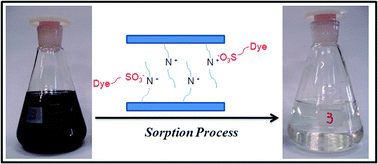Magnesium phyllosilicates with organic groups anchored onto the inorganic polymeric backbones as mono- or bifunctional entities were investigated for dye removal from aqueous solution. The synthetic methodology consisted in obtaining organofunctionalized nanostructured materials from silylating agents of general formula R1–Si(OCH3)3, in which R1-trimethoxysilane includes chains containing the functional groups: 3-aminopropyl, octadecyldimethyl(silylpropyl)ammonium, 3-mercaptopropyl, 3-ethylenediamine and 3-diethylenetriamine. The sol–gel process leads to lamellar structures similar to those of natural silicate with basal distances, in good agreement with the R1 contained in the precursor agent. The pendant electrophile attached on the new phyllosilicates interacts with the negative charge of dyes used in the textile industry, such as Reactive Yellow GR, Reactive Red RB and Reactive Blue RN. The sorption studies showed that the phyllosilicate containing octadecyldimethyl(3-trimethoxysilylpropyl)ammonium chloride agent, P-OCT, presented the highest sorption capacities of 1343, 1286 and 344 mg g−1 for the dyes Yellow GR, Blue RN and Red RB, respectively, which are better than for other sorbing materials. Real samples from textile effluents assayed demonstrated that the sorption did not need to adjust the initial pH, with surface saturation after 3 h and the minimum mass necessary was 2.5 g dm−3 of P-OCT for the best efficiency. This is thus a very promising material for textile effluent treatment, with good structural disposition of the pendant groups.

You have access to this article
 Please wait while we load your content...
Something went wrong. Try again?
Please wait while we load your content...
Something went wrong. Try again?


 Please wait while we load your content...
Please wait while we load your content...